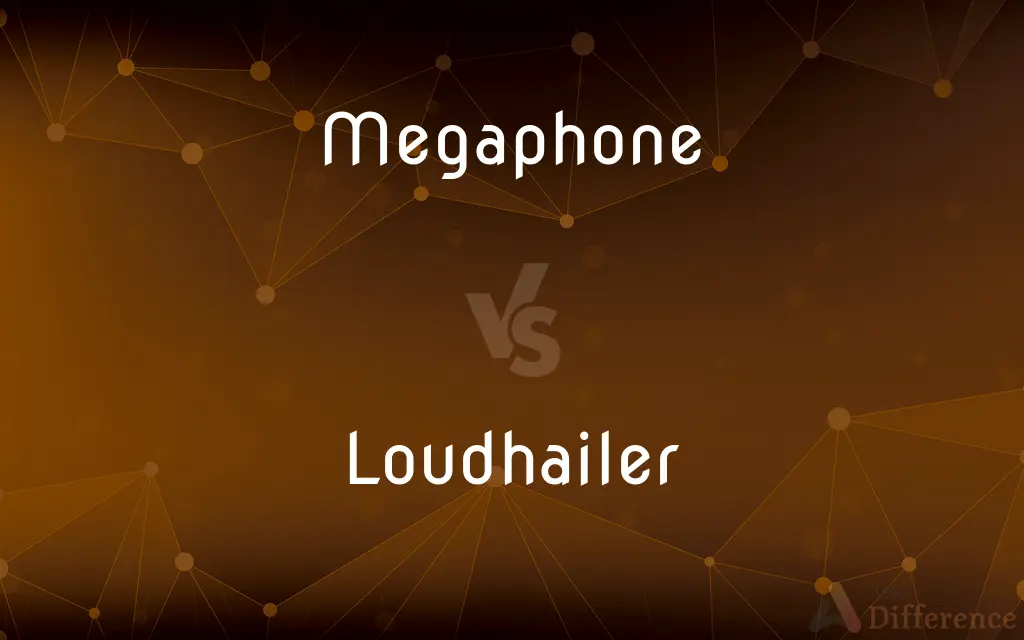Megaphone vs. Loudhailer — What's the Difference?
By Urooj Arif & Maham Liaqat — Updated on March 14, 2024
A megaphone amplifies a speaker's voice to reach a wider audience, focusing on voice projection, while a loudhailer, synonymous with megaphone in usage, emphasizes electronic amplification for clarity over distances.

Difference Between Megaphone and Loudhailer
Table of Contents
ADVERTISEMENT
Key Differences
The term "megaphone" historically refers to a cone-shaped device that amplifies sound through its shape, enhancing the voice's projection without electronic aid. It relies on the acoustic properties of its design to increase volume. On the other hand, "loudhailer" is often used interchangeably with megaphone but can specifically denote an electronic device that amplifies and projects sound, including voices, through electronic amplification, making it clearer over longer distances.
In practice, the distinction between a megaphone and a loudhailer has blurred, with both terms being used to describe devices that help project voices or sounds at higher volumes, regardless of whether they are purely acoustic or electronic. However, when emphasizing the technological aspect, "loudhailer" suggests a device with electronic components designed to amplify sound more efficiently and with options for tone adjustment or recorded message playback.
Megaphones are commonly seen at sporting events, rallies, and situations where voice projection is necessary without the aid of electronics, emphasizing simplicity and direct acoustic amplification. Loudhailers, while functionally similar, imply the use of electronic amplification, making them suitable for not only projecting voices but also broadcasting recorded messages, which is particularly useful in emergency situations or large gatherings.
Despite these nuances, the primary function of both devices is to amplify sound, making it audible over larger areas than would be possible with the unaided human voice. Whether referred to as a megaphone or loudhailer, the choice of term often depends on regional preferences or the specific context in which the device is used.
Both megaphones and loudhailers play crucial roles in public communication, ensuring that messages reach their intended audience with greater clarity and volume. The preference for one term over the other does not significantly affect the device's purpose or functionality but may reflect slight differences in design or capability, particularly in terms of electronic features.
ADVERTISEMENT
Comparison Chart
Design
Cone-shaped, acoustic
Often electronic, capable of various functions
Amplification
Acoustic, through design
Electronic, with adjustable volume and tone
Usage
Sporting events, rallies, without electronic aid
Emergency situations, large gatherings, with electronics
Functionality
Voice projection
Voice projection, recorded message playback
Preference
Simplicity and direct sound amplification
Efficiency and versatility with electronic amplification
Compare with Definitions
Megaphone
Used to increase volume for speeches or announcements.
The event organizer announced the winners through a megaphone.
Loudhailer
Features electronic amplification and tone control.
Using the loudhailer, emergency instructions were clearly broadcasted.
Megaphone
Acoustically amplifies sound without electronics.
She raised her voice through the megaphone, rallying the crowd.
Loudhailer
Suitable for diverse environments, including noisy settings.
The protest leader used a loudhailer to communicate with participants.
Megaphone
A cone-shaped device for amplifying and directing the voice.
The coach used a megaphone to call out instructions.
Loudhailer
Can broadcast recorded messages or sounds.
The loudhailer played a recorded evacuation alert during the drill.
Megaphone
Simple design focusing on natural sound projection.
The tour guide carried a megaphone to address the group.
Loudhailer
An electronic device that amplifies voice or sound.
The captain issued orders through the loudhailer to the crew.
Megaphone
Relies on physical shape for amplification.
He spoke into the megaphone, and his voice echoed across the field.
Loudhailer
Often used in large gatherings for clarity over distances.
Announcements were made through a loudhailer for all attendees to hear.
Megaphone
A megaphone, speaking-trumpet, bullhorn, blowhorn, or loudhailer is usually a portable or hand-held, cone-shaped acoustic horn used to amplify a person's voice or other sounds and direct it in a given direction. The sound is introduced into the narrow end of the megaphone, by holding it up to the face and speaking into it, and the sound waves radiate out the wide end.
Loudhailer
(British) A megaphone or bullhorn.
Megaphone
A funnel-shaped device used to direct and amplify the voice.
Megaphone
A bullhorn.
Megaphone
To transmit (a message) or speak through a megaphone.
Megaphone
A portable, usually hand-held, funnel-shaped device that is used to amplify a person’s natural voice toward a targeted direction.
Megaphone
(figuratively) Mouthpiece or promoter; one who speaks for or publicizes on behalf of another.
Megaphone
(organic compound) A cytotoxic neolignan obtained from the laurel Aniba megaphylla.
Megaphone
To use a megaphone; to speak through a megaphone.
Megaphone
A device to magnify sound, or direct it in a given direction in a greater volume, as a very large funnel used as an ear trumpet or as a speaking trumpet.
Megaphone
A cone-shaped acoustic device held to the mouth to intensify and direct the human voice
Common Curiosities
Why might someone choose a loudhailer over a megaphone?
For its electronic amplification capabilities, versatility in functions, and clearer sound projection in various environments.
How does a loudhailer differ from a traditional megaphone?
A loudhailer typically includes electronic amplification and may offer additional features like tone control or the ability to play recorded messages.
What is the primary function of a megaphone?
The primary function is to amplify and project the voice or sound acoustically over a distance.
Can megaphones operate without batteries?
Yes, traditional megaphones do not require batteries, as they amplify sound acoustically.
Can megaphones include electronic features?
While traditional megaphones are acoustic, modern versions may incorporate electronic elements, blurring the line with loudhailers.
What's the significance of a loudhailer in crowd control?
It allows authorities to communicate effectively with large groups, ensuring messages are heard clearly and promptly.
What materials are megaphones typically made from?
They can be made from various materials, including metal, plastic, or even paper for temporary use.
How do loudhailers impact public safety?
They enhance public safety by enabling clear, efficient communication during emergencies or large public events.
Can loudhailers be used for entertainment purposes?
Yes, they can be used to amplify music or announcements at events, adding to the entertainment experience.
What advantages do electronic loudhailers have?
They offer clearer sound quality, volume control, and the option to broadcast recorded messages.
Are loudhailers only used for emergencies?
While often used in emergencies, loudhailers are also common in events, protests, and anywhere clear communication over distance is needed.
Is there a difference in the distance a megaphone and a loudhailer can cover?
Generally, loudhailers can project sound over longer distances more clearly, thanks to electronic amplification.
How do you use a megaphone effectively?
Speak directly into the narrow end, and project your voice through the wide end towards your intended audience.
Are megaphones considered outdated?
Not necessarily, as they are still valued for their simplicity and reliability, especially in situations where electronic devices might fail.
Why is volume control important in loudhailers?
It allows the user to adjust the sound level based on the environment, ensuring messages are delivered effectively without causing discomfort.
Share Your Discovery

Previous Comparison
Inventorized vs. Inventoried
Next Comparison
Primipara vs. NulliparaAuthor Spotlight
Written by
Urooj ArifUrooj is a skilled content writer at Ask Difference, known for her exceptional ability to simplify complex topics into engaging and informative content. With a passion for research and a flair for clear, concise writing, she consistently delivers articles that resonate with our diverse audience.
Co-written by
Maham Liaqat















































